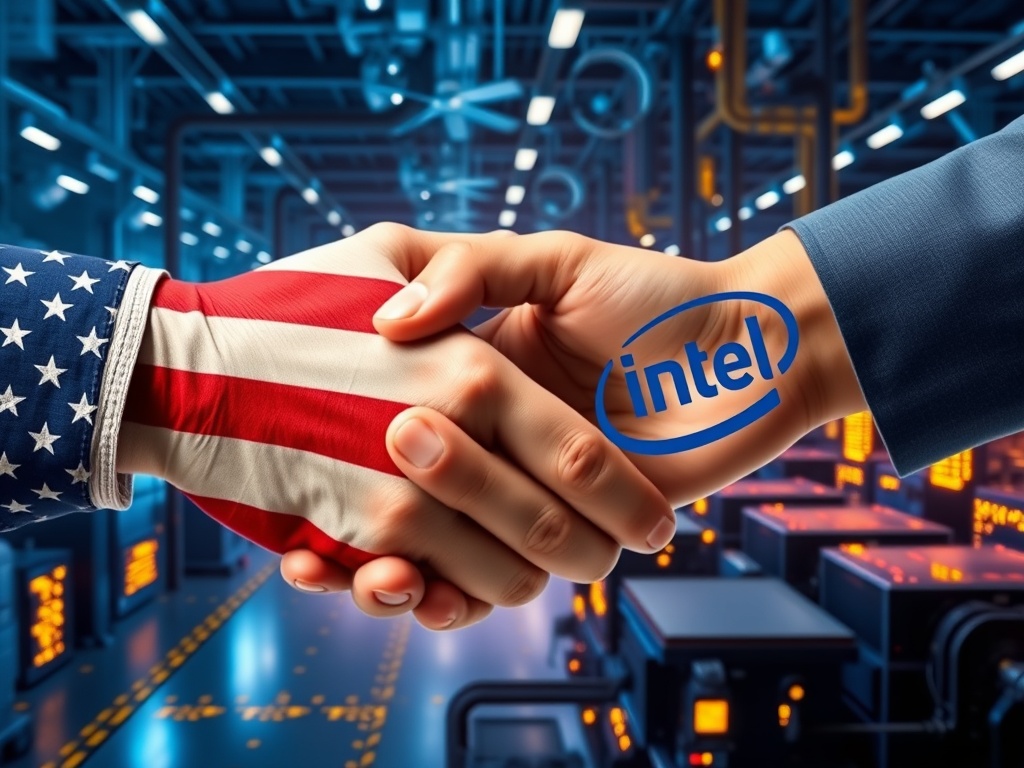BitcoinWorld

Intel Investment: Unveiling a Historic US Government Stake in Semiconductor Manufacturing
In the fast-evolving landscape where technology intersects with geopolitics, even the most established tech giants find themselves at the center of unprecedented government interventions. For the discerning reader of Bitcoin World, understanding these seismic shifts in traditional markets is crucial, as they often ripple through the broader economy, impacting everything from investment strategies to the very infrastructure underpinning digital assets. A groundbreaking report from Bloomberg indicates that the U.S. government is now reportedly in advanced discussions to acquire a significant Intel Investment, a move that could redefine the relationship between state and enterprise in the critical semiconductor sector.
What’s Driving This Monumental Intel Investment?
The whispers of a direct U.S. government stake in semiconductor behemoth Intel are more than just market speculation; they signal a profound strategic pivot. Posted on August 14, 2025, this development stems directly from the Trump administration’s ongoing efforts to bolster domestic manufacturing and secure vital supply chains. The core motivation behind this potential Intel Investment is clear: to accelerate the expansion of Intel’s U.S. manufacturing capabilities, particularly its much-anticipated Ohio chip factory. This factory is not just a building; it represents a cornerstone of America’s ambition to reclaim its lead in chip production, reduce reliance on overseas fabs, and safeguard national security interests.
The push for this government involvement isn’t new. It aligns with broader initiatives like the CHIPS and Science Act, which aims to provide billions in subsidies for domestic semiconductor production. However, a direct equity stake goes a step further, indicating a deeper, more hands-on approach from Washington. This level of intervention highlights the perceived urgency and strategic importance of semiconductors, which are the fundamental building blocks of almost every modern technology, from smartphones and AI systems to advanced military hardware.
The Broader US Semiconductor Strategy in Play
This proposed stake in Intel is a critical piece of a much larger puzzle: the overarching US Semiconductor Strategy. For years, the U.S. has grappled with the implications of its reliance on foreign-based chip manufacturing, particularly in regions prone to geopolitical instability. The COVID-19 pandemic exposed the fragility of global supply chains, leading to widespread shortages that impacted industries worldwide, including automotive, consumer electronics, and even critical infrastructure. This vulnerability has underscored the imperative for the U.S. to onshore more of its chip production.
Beyond supply chain resilience, the US Semiconductor Strategy is also deeply intertwined with geopolitical competition, especially with China. Both nations are locked in a technological race, with semiconductors at its heart. By strengthening domestic champions like Intel, the U.S. aims to maintain its technological edge, protect its intellectual property, and ensure that its military and economic power is not undermined by dependencies on rival nations. This strategic imperative often translates into direct government support, whether through subsidies, tax incentives, or, as now being discussed, direct equity participation.
Key aspects of this strategy include:
- National Security: Ensuring access to advanced chips for defense and intelligence.
- Economic Competitiveness: Creating high-paying jobs and fostering innovation domestically.
- Supply Chain Resilience: Reducing vulnerability to global disruptions and geopolitical tensions.
- Technological Leadership: Maintaining the U.S. position at the forefront of chip design and manufacturing.
Boosting Domestic Chip Manufacturing Capacity: The Ohio Dream
At the heart of the proposed government stake lies the ambitious goal of boosting domestic Chip Manufacturing capacity. Intel’s planned Ohio factory is a prime example of this aspiration. While facing delays, this facility is envisioned to be a cutting-edge hub for advanced chip production, creating thousands of direct and indirect jobs and revitalizing the American industrial landscape. The U.S. government’s potential investment could provide the necessary capital injection to overcome these delays and accelerate the factory’s completion, ensuring a faster path to increased domestic output.
The significance of scaling up Chip Manufacturing within the U.S. cannot be overstated. It’s not merely about assembling chips; it’s about mastering the entire ecosystem, from research and development to fabrication and packaging. This holistic approach aims to create a self-sufficient semiconductor industry that can innovate and produce at scale, independent of external factors. The Ohio project, if fully realized with government backing, could serve as a blueprint for future public-private partnerships aimed at critical industrial revitalization.
This initiative also carries significant economic benefits:
| Benefit Area | Impact |
|---|---|
| Job Creation | Thousands of direct manufacturing jobs, plus indirect jobs in supporting industries. |
| Economic Growth | Increased GDP contribution from high-value manufacturing. |
| Technological Advancement | Fostering innovation and R&D in cutting-edge semiconductor technologies. |
| Supply Chain Stability | Reduced reliance on foreign sources, enhancing national resilience. |
The Implications of a Direct Government Stake: A Double-Edged Sword?
A direct Government Stake in a publicly traded company like Intel is an extraordinary measure, typically reserved for times of severe economic crisis or national emergency. While it promises to infuse capital and align corporate objectives with national interests, it also raises questions about market principles, corporate governance, and potential political interference. The recent backdrop to these discussions involves significant tension between the Trump administration and Intel’s leadership.
Less than a week before these discussions surfaced, President Donald Trump reportedly insisted on the resignation of Intel CEO Lip-Bu Tan, citing “perceived conflicts of interest” without providing specific reasons. This demand followed a letter from Republican U.S. Sen. Tom Cotton to Intel’s board, questioning Tan’s alleged ties to China. Tan met with the Trump administration on August 11 to address these concerns and explore avenues for collaboration, a meeting that, according to Bloomberg, directly led to the discussions of a U.S. government stake.
This situation underscores the delicate balance involved in a Government Stake. While it could provide stability and strategic direction, it also introduces the risk of political influence impacting business decisions, potentially leading to less agile operations or market distortions. Investors will be keenly watching how such a stake might affect Intel’s autonomy, its competitive position, and its long-term shareholder value.
The Future of AI Chip Development and National Security
Beyond traditional computing, Intel plays a pivotal role in the future of AI Chip Development. As artificial intelligence continues to permeate every aspect of technology, from data centers to edge devices, the demand for specialized AI chips is skyrocketing. These chips are crucial not only for commercial innovation but also for national security applications, including advanced surveillance, autonomous systems, and cyber defense.
A government investment in Intel could specifically earmark funds or strategic directives towards accelerating Intel’s capabilities in AI Chip Development. This would ensure that the U.S. maintains a competitive edge in a technology that is increasingly seen as the next frontier of global power. By fostering domestic AI chip production, the U.S. can mitigate risks associated with relying on foreign suppliers for critical AI infrastructure, thus safeguarding its strategic interests in the rapidly evolving AI landscape.
The synergy between government backing and Intel’s research and development prowess could unlock significant breakthroughs, ensuring that next-generation AI technologies are designed, developed, and manufactured securely within the U.S. This is vital for maintaining both economic competitiveness and national defense capabilities in an increasingly AI-driven world.
Challenges and the Path Forward
While the prospect of a U.S. government stake in Intel promises significant benefits for domestic manufacturing and national security, it is not without its challenges. Navigating the complexities of government oversight in a commercial enterprise, ensuring fair market competition, and managing the perceptions of international partners will be crucial. The market will also closely scrutinize the terms of any such deal, particularly regarding governance and the exit strategy for the government’s stake.
Moreover, the controversy surrounding Intel CEO Lip-Bu Tan highlights the political sensitivities inherent in such high-stakes negotiations. Reconciling corporate autonomy with national strategic imperatives will require careful diplomacy and transparent frameworks. For Intel, this could mean balancing its global business interests with heightened domestic obligations.
Ultimately, this potential partnership represents a bold experiment in industrial policy. If successful, it could serve as a powerful model for how governments can proactively support critical industries to achieve national objectives. The outcome will not only shape Intel’s future but also profoundly influence the trajectory of U.S. technological leadership and its position in the global semiconductor race.
Conclusion: A New Era for U.S. Tech Sovereignty
The reported discussions of a U.S. government stake in Intel mark a watershed moment for American industrial policy and technological sovereignty. This unprecedented move underscores the critical importance of semiconductors to national security and economic prosperity. By potentially investing directly in Intel’s domestic manufacturing capabilities, particularly its Ohio factory, the U.S. aims to fortify its supply chains, reduce foreign dependencies, and accelerate its lead in vital areas like AI chip development. While challenges related to market dynamics and corporate governance remain, this strategic intervention signals a robust commitment to rebuilding America’s industrial might and securing its technological future. The ripples of this decision will undoubtedly be felt across global markets, influencing everything from trade policies to the very infrastructure that supports our digital world.
To learn more about the latest AI market trends, explore our article on key developments shaping AI features, institutional adoption, etc.
This post Intel Investment: Unveiling a Historic US Government Stake in Semiconductor Manufacturing first appeared on BitcoinWorld and is written by Editorial Team





